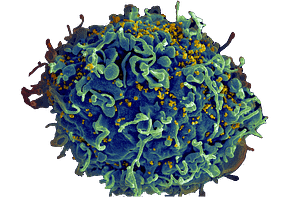New Crohn’s Disease Drug Stimulates Immunity While Down-Regulating Unproductive Inflammation. Some Liken it to “Prednisone Without the Side Effects.”
Recently, scientists have developed new methods of detecting intracellular bacteria. Intracellular bacteria are bacteria that invade and live inside the cell when it gives them an advantage in the host. They are less common and harder to eradicate than extracellular bacteria. Ziehl-Neelsen staining is a technique used by microbiologists to identify certain classes of bacteria, mainly Mycobacteria. Mycobacteria (including MAP) will appear red when stained with the Ziehl-Neelsen method. A team out of New Zealand has discovered Ziehl-Neelsen positive bacteria in blood cells of dendritic cell and macrophage lineage. Macrophages (literally “big eaters”) are white blood cells that clean the body of unwanted particles, such as bacteria and dead cells. A simplistic explanation of dendritic cells is that they are white blood cell scouts. They search for things that should not be present and then tell the immune system to destroy any foreign invaders. Both macrophages and dendritic cells are key components of the innate immune system. The importance of finding a Ziehl-Neelsen positive unidentified bacterial species inside circulating macrophages is currently under investigation.
Crohn’s disease is a chronic inflammatory bowel disease of unknown origin. Although long considered to be an autoimmune disorder, the autoimmune hypothesis has been abandoned. Recently, Crohn’s disease has been shown to be associated with innate immune deficiency. Gene mutations involving pathways associated with the recognition and response to intracellular infections are risk factors for developing Crohn’s disease. Single Nucleotide Polymorphisms (a common type of genetic variation) associated with Crohn’s disease involve pathways associated with macro-autophagy, the evolutionary conserved mechanism by which cells destroy intracellular microbial invaders. Impaired autophagy results in dysregulated cytokine production, impaired MHC-antigen presentation and dysregulated adaptive immune responses. The result is an inability to eradicate intracellular microbial pathogens, dysregulated ineffective immune responses, unproductive inflammation, and a global phenotype of a chronic idiopathic inflammatory disease that would currently be categorized as being an autoimmune disease.
Basically, this means that the genetic variations in Crohn’s disease patients interfere with fundamental immune processes of the immune response, allowing some bacterial species to take advantage of this chink in the immune armor.
Since Crohn’s disease is associated with Mycobacterium avium paratuberculosis, we hypothesize that MAP is one of the pathogenic microbes that successfully infects macrophages and triggers immune-mediated destructive processes in subjects with a predisposing genetic background. This argument is strengthened by the fact that MAP causes similar diseases in other mammals. In cattle, it is known as Johne’s disease. The possible involvement of other bacteria is uncertain but likely.
Based on the above information, logic suggests that therapies that enhance innate immunity, regulate immune signaling and control ineffective inflammation will restore immune efficacy so that a patient’s immune system can effectively handle a chronic intracellular microbial disease. We assert that eradication of a persistent infection of these professional antigen presenting cells (macrophages/dendritic cells) will restore healthy immune function and lead to improved management of the disease.
Formulated EpiBro (or FepiBro) possesses the above qualities. Data from human clinical trials using FepiBro in HIV/AIDS, tuberculosis and malaria suggest that it will be beneficial in Crohn’s Disease. In prior human trials, FepiBro demonstrated activity against intracellular pathogens of malaria and Mycobacterium tuberculosis. The drug decreased inflammatory cytokines and increased circulating dendritic cells, NK-T cells and HIV-specific CD8 T cells in end-stage AIDS patients. It cleared circulating malarial parasites in patients with Falciparum malaria. It reduced the rate of clinical tuberculosis in end-stage AIDS patients. After 120 days of therapy no further cases of pulmonary tuberculosis were observed. Although the molecular targets and intracellular pathways that are influenced by FepiBro are not well understood at this time, it is thought that the beneficial effects are due to an up-regulation of innate immunity.
FepiBro stimulates innate immunity and has a strong anti-inflammatory effect. Both of these effects predictably would be beneficial in Crohn’s disease. Destructive inflammation stems from innate immune deficiency associated with persistent infection of macrophages and a dysregulated immune response, discussed above. FepiBro’s ability to enhance innate immunity should be beneficial. FepiBro’s ability to quickly down-regulate inappropriate pro-inflammatory cytokines (TNF, IL-6, IL-1b) and ameliorate the consequences of inappropriate inflammation should provide subjective symptomatic relief to patients. The anti-inflammatory effects may be observed within a few days to weeks of starting therapy. The immune enhancing effect may take longer, but potentially offers the hope of long-term management or even cure when combined with appropriate antibiotic regimens. The only side effect observed to date is redness at the injection site. It can be said that FepiBro offers the benefits of prednisone but without the side effects, and that it stimulates immunity rather than suppressing it.
In summary, recent discoveries implicate innate immune deficiency as an associated and predisposing factor in Crohn’s disease. We submit that innate immune deficiency predisposes the patient to microbial infections that are the causal agents of the disease. We hypothesize that enhancing innate immunity and controlling destructive inflammation will provide therapeutic benefit.

 by
by